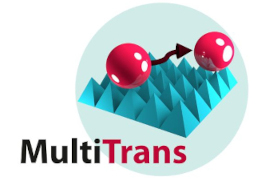Research Projects - water splitting, hydrogen production & co

Electro- and Photocatalytic CO2 reduction with [NiFe]-Chalcogenides
Aim of this project is the development of Nickel-Iron-Oxysulfide nanoparticles for CO2 reduction.
Project partner: Dr. Ulf-Peter Apfel (Ruhr-Universität Bochum)

Porous, electrospun fiber mats with high proton conductivity for composite membranes
The aim of this project is the production of flexible SiO2 fiber mats via electrospinning, which can be functionalized with sulfonic acid groups and benzimidazole groups for high proton conductivity. Different strategies such as the spinning of already functionalized SiO2 particles or the post-synthetic functionalization of SiO2 fiber mats were investigated. The produced fiber mats were tested for their proton conductivity in defined air humidity and temperature-dependent using impedance spectroscopy.

CO2SimO - Photoelectrochemical CO2 reduction with simultaneous oxidative recovery
The CO2SimO project will develop a technology that uses solar energy to convert the greenhouse gas carbon dioxide (CO2) into the energy source methane and will at the same time produce the important bleaching and disinfecting agent hydrogen peroxide. This photoelectrochemical cell (PEZ) is realized by us in cooperation with 2 companies, two research institutes and the University of Hanover. The AG Marschall is developing new photocatalysts, new oxides that can convert CO2 using solar energy.

Ammonia on demand: Catalytic N2 reduction on photo-charged tailored TiO2 aerogels
Project partners: Professor Dr. Barbara Milow (DLR Cologne); Professor Dr. Dirk Ziegenbalg (University of Ulm)
A concept for a sustainable and inexpensive process to generate ammonia on-demand is systematically investigated. This project will present a strategy to charge and store electrons upon light irradiation in a nanostructured semiconductor (TiO2 aerogels), which can be then discharged in the dark with N2 to form ammonia catalytically. This enables the production of ammonia on demand at any time. Moreover, a reactor concept will be developed to perform and investigate the on-demand ammonia synthesis in a decentralized way. This reactor allows for a separation of light-harvesting and the actual N2 reduction, enabling an independent investigation of the reaction conditions for each reaction step.

Electro- and Photocatalytic N2 conversion with transition metal chalcogenides over 2D and 3D structured electrodes (NI-CONSTRUCT)
Project partners: Professor Dr. Andrea Balducci (Friedrich-Schiller-Universität Jena); Professor Dr.-Ing. Christina Roth (University of Bayreuth)
The present project aims at establishing suitable electrode/electrolyte combinations for the electrocatalytic and photoelectrocatalytic reduction of N2 (NRR). In particular, ionic liquids(IL)-based electrolytes, 3D nanostructured electrodes, and novel catalyst materials based on non-noble metal chalcogenides which mimic the natural role model of the catalytic centers of nitrogenases will be investigated. Therefore, novel ILs realized during the project will be also immobilized on and within fibrous structures, e.g. using the electrospinning approach, and the effect of improved 3-phase boundaries and shortened diffusion paths for educt, product and charge carriers on NRR performance will be determined.

Metal oxide polymer nanocomposites

Photocatalytically-active membranes based on spider silk proteins
From May 2023
Project Partners: Prof. Dr. Thomas Scheibel (University of Bayreuth), AMSilk GmbH, Audi AG

Project A03: Oriented growth and oriented transport of ions in aligned pores
In project A03, 2D hexagonally ordered, vertically aligned pore systems based on SiO2 are used to systematically study the transport characteristics of ionic carriers in these highly anisotropic channels. Measurements of the proton transport and the catalytic activity of the 1D Co3O4 electrocatalyst materials produced therein will be fed back to the synthesis of the pore structures with the aim of investigating their influence on the transport of the respective ions.

Project B02: Electron transfer in semiconductor electrodes with immobilized 3d metal complexes for photoelectrochemical water oxidation
Project B02 will develop and investigate a novel photoanode architecture for water oxidation. Tailor-made metal complexes will be immobilised as catalysts on highly active mesoporous semiconductor photoelectrodes. This will mediate the electron transport across the interfaces from the semiconductor to the complexes and the electrolyte, as well as the electrolyte transport in the channels of the pore system. Thus, electron transport is linked with mass transport inside the porous channels. Additional DFT calculations will yield information on the electronic coupling between the semiconductor-complex interfaces, and on the charge transport through the combined systems.

